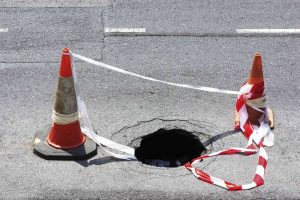Chances are, you’ve seen a video or picture of a sinkhole somewhere in the world. These scary phenomena can occur throughout the globe and cause major damage, depending on what is above the surface. What are sinkholes and how do they form?
Sinkhole 101
Sinkholes form over many years as a result of very specific geological and environmental processes. Sinkholes occur as a result of karst processes. Karst processes exist when bedrocks are soluble, or able to dissolve over time in water. The most common bedrocks that lead to sinkholes are limestone, dolomite, gypsum, and anhydrite. A sinkhole can seem to appear out of nowhere since there will be no signs of external surface damage or drainage. Whenever moisture comes down from the skies, it will go directly below the surface into the sinkhole that is brewing. Sinkholes can be any size, from smaller than a meter to over 100 meters deep.
Types of Sinkholes
Sinkholes can be created by humans through various urban planning or environmental decisions that have an impact on the surface below. Some of the most common human causes of sinkholes include groundwater pumping, construction activities, and urban development. Everything from mining to drilling can lead to the formation of a sinkhole.
The most common types of sinkholes are:
- Dissolution sinkholes: These form over time as rainwater goes through joints in limestone and dissolved rock leaves. The limestone will actually disappear or dissolve over time.
- Cover subsidence sinkholes: These sinkholes happen over long periods of time in areas where the top layer contains permeable sand.
- Cover-collapse sinkholes: These are the most dangerous and most well-known type of sinkhole. They can develop rapidly (in only a few hours) and can be massive in scale. If the covering sediments have a high amount of clay and surface erosion has occurred over time, the bowl-shaped depression will form. These sinkholes happen when the ground above the hole simply cannot bear the weight.
GPR Services from Concrete Visions
Concrete Visions has over 12 years of experience and expertise in concrete scanning and we know how to detect any problems lurking beneath the surface. We use ground penetrating radar accurately and expertly and are familiar in many other methods that can be used when appropriate like concrete x-ray and electromagnetic conductivity. We are also very familiar with the latest construction safety techniques and train all of our workers to do their work quickly, accurately, and safely. If you would like to learn more about how we can help you, give is a call at (410) 766-2210 or visit us online. For more articles and tips, follow us on Facebook, Twitter, LinkedIn, and Google+.

